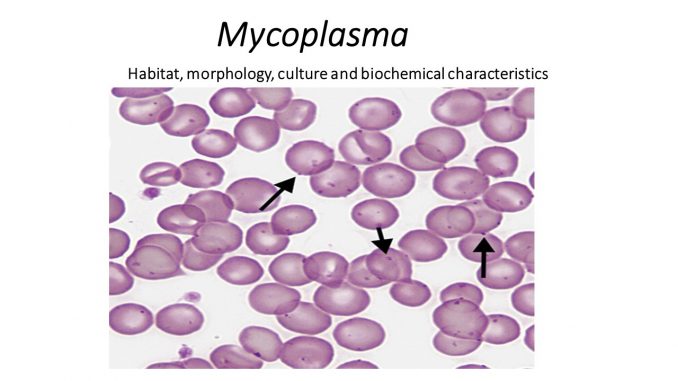
Mycoplasma: habitat, morphology, culture and biochemical characteristics
- Mycoplasma are pleuromorphic smallest living organism, also known as Pleuropneumonia like organism (PPLO).
- Belongs to family Mycoplasmataceae
Habitat:
- Ubiquitous in nature
- Plants, Insects and other animals serves as reservoir
- Mycoplasma resides in mucosa of upper respiratory tract (URT) and urogenital tract of human. They are also found in oral cavity.
- Medically important species are: Mycoplasma pneumoniae, M. hominis, M. genitalium
Morphology:
- Smallest pleuromorphic bacteria
- Size: 0.2µm in diameter
- Shape varies, they may be coccoid or filamentous depending upon species and growth conditions
- They lack cell wall so they are pleuromorphic and do not stain with conventional bacteriological stains.
- All members of mycoplasma contains cholesterol containing cell membrane
- Electron microscopy revels M. pneumoniae and other some pathogenic mycoplasma contains terminal structure which helps in attachment.
- Mycoplasma is bridge between bacteria and virus. They differ from virus is that they contains both DNA and RNA and can reproduce in cell free media.
- Genome is 580Kbp
Cultural and biochemical characteristics:
- Mycoplasma spp are facultative anaerobes but M. pneumoniae is strict aerobe
- Optimum temperature requirement for growth is 35-37°
- They are fastidious and grow slowly in culture media
- All mycoplasma except Acholeplasma requires cholesterol or sterol and Nucleic acid precursors for growth.
- They grow on enrichment media with 20% human or horse serum.
- Human or horse serum provides cholesterol and fatty acids which is required for synthesis of cell membrane since these bacteria are unable to synthesize the component of cell membrane by themselves.
- They gives small sizeFried egg colony on semi solid enriched media containing 20% horse serum, yeast extract and DNA after 7-12 days of incubation in CO2 incubator.
- The growth slow in agar media than in broth culture
- Surface glycoprotein of M. pneumoniae cross reacts with I-antigen of human RBC at 4°
- Cell wall inhibiting drugs such as Penicillin and Cephalosporin are ineffective drugs because they lacks cell wall.
- M. pneumoniae, M. genitalium, M. fermentans and M. penetrans ferment glucose while M. hominis is glucose non fermenter.
- M. hominis hydrolyses arginine
- Mycoplasma pneumoniae is able to reduce 2,3,5-triphenyl-tetrazolium chloride
Most common medically important species is M. pneumoniae.
Disease and infection caused by Mycoplasma pneumoniae:
- Pneumonia
- Patchy bronchopneumonia
- Pharyngitis
- Tracheobronchitis
- Otitis media
- Pleural infection
- Septic arthritis
